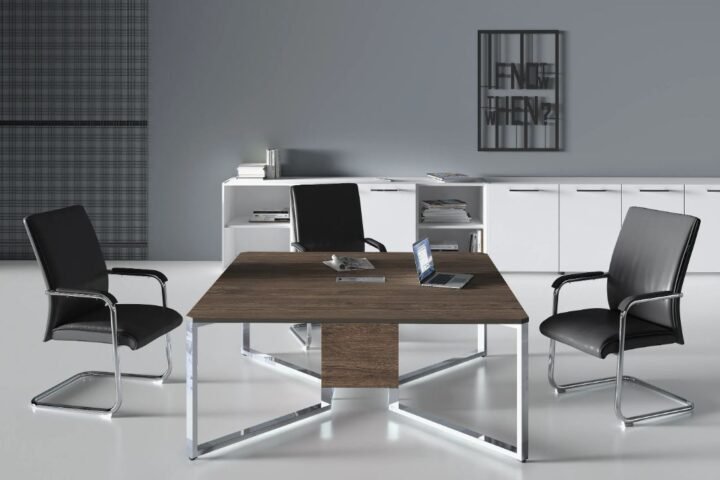In today’s fast-paced business environment, the office isn’t just a place to work—it’s a space that defines productivity, comfort, and style. One of the most overlooked yet essential components of this space is the office table. The right office table design can drastically improve focus, organization, and overall office aesthetics. Whether you’re setting up a home office, redesigning your commercial workplace, or looking to upgrade your furniture, investing time in choosing the perfect table is crucial. From sleek minimalist styles to ergonomic masterpieces, the market is filled with a variety of options that cater to different work styles and business needs. Before you buy, understanding the relationship between design, function, and comfort can help you make a well-informed decision that pays off in both performance and satisfaction.
How Office Table Design Impacts Productivity and Comfort
When it comes to enhancing efficiency at work, furniture design plays a vital role. An intelligently designed office table not only organizes your workspace but also significantly influences your posture, attention span, and energy levels. Ergonomic office table designs are tailored to support your body’s natural posture, reducing fatigue and lowering the risk of repetitive strain injuries. Adjustable height tables, for example, allow users to alternate between sitting and standing positions, which promotes blood circulation and prevents discomfort from prolonged sitting. Features like cable management systems, integrated storage, and clutter-free surfaces all contribute to a more focused and productive work environment. The aesthetics of your office table also affect your mood—sleek lines, modern finishes, and clean surfaces create an atmosphere of calm and order that boosts concentration.
Choosing the Right Office Table Design for Your Workspace
Selecting the ideal office table design depends on various factors including the size of the room, the nature of work, and the user’s individual preferences. For smaller spaces, corner tables or wall-mounted folding designs work well to maximize available room. Larger corporate setups may benefit from L-shaped or U-shaped configurations that accommodate multiple screens, paperwork, and collaborative tasks. Material is another key aspect—wood, metal, and glass each bring a unique look and functionality. Solid wood offers warmth and durability, while glass adds a contemporary touch and enhances a sense of openness. Storage features like drawers, cabinets, and modular add-ons can make an office table more efficient for day-to-day tasks. Even color psychology plays a role—cool tones like white and grey promote calmness, while bold colors like black or navy can project professionalism and authority.
Modern Office Table Design Trends to Consider
The world of office table design has evolved significantly, especially with the rise of remote work and hybrid office models. Minimalism continues to be a strong trend, with clean surfaces, hidden storage, and neutral palettes dominating the scene. Designers are now integrating technology into office tables, such as built-in wireless chargers, USB ports, and adjustable lighting. Sustainability is also influencing choices, with more people opting for eco-friendly materials and responsibly sourced wood. Height-adjustable or sit-stand desks are becoming a staple in modern workspaces, allowing users to tailor the table to their comfort. Collaborative designs are also on the rise, featuring larger tables that promote group interaction while still maintaining individual workspace boundaries. Smart storage solutions, modular add-ons, and flexible configurations are making modern office tables highly adaptive to changing needs.
Key Features to Look for in an Office Table
With the wide range of options available, it’s easy to get overwhelmed. However, there are some essential features to look out for when choosing your office table design. First and foremost is durability—your table should be sturdy enough to support computers, paperwork, and daily usage without showing signs of wear. Look for reinforced edges, strong joints, and high-quality materials. The design should also cater to comfort, offering legroom and a surface height that supports good posture. Integrated storage options such as drawers and shelves help keep the workspace tidy and efficient. If your job involves multiple monitors or technical equipment, consider a table with ample depth and cord management features. For shared workspaces, privacy panels or screens can provide a balance between collaboration and personal focus. A good office table should not only match your current needs but also adapt to future changes in your workflow.
Office Table Design for Home Offices
As more professionals work remotely, the demand for stylish yet functional office table designs for home use has skyrocketed. A home office table should blend seamlessly with the existing decor while offering the efficiency of a professional setting. Compact designs with multi-use features work best in tight spaces—think wall-mounted desks, foldable tables, or convertible console tables. Style plays a bigger role at home, where the office table often shares space with living areas or bedrooms. Look for pieces that combine form and function, such as Scandinavian designs with sleek wooden finishes or industrial styles that pair metal frames with reclaimed wood. Comfort should not be compromised—invest in ergonomic options with adjustable heights or built-in storage to keep your work materials organized. Good lighting, paired with a well-designed office table, can enhance mood and reduce eye strain during long hours of screen time.
Future-Proofing Your Workspace with Smart Office Table Design
As workspaces continue to evolve, so should your office table design. The future of work demands adaptability, and furniture that can keep up with changing technologies and habits. Smart office tables are gaining popularity, offering features like programmable height settings, built-in speakers, wireless charging docks, and even AI-powered organization tools. Some designs come with integrated LED lighting and motion sensors to automatically adjust based on user presence. Investing in a forward-thinking office table means you’re not just buying furniture, but a long-term solution that enhances work-life balance. Hybrid spaces require more from their furniture—modularity, mobility, and multifunctionality are now essential. Whether you’re designing for solo work, collaborative brainstorming, or client meetings, choosing a smart and scalable office table design ensures your setup remains relevant in a rapidly changing world.
Conclusion: Invest in a Thoughtful Office Table Design
The importance of the right office table design cannot be overstated. It is more than just a surface to work on—it is a centerpiece of your workspace that affects productivity, posture, and peace of mind. Whether you’re an entrepreneur working from a home office or managing a team in a corporate setup, selecting the right office table can transform your work experience. Take into account your space, workflow, and personal preferences when exploring the many styles and features available today. From minimalist designs to technology-integrated models, the modern office table is both a tool and a statement of professionalism. For those looking to make a smart and stylish investment, Office table offers a comprehensive range of expertly crafted options that balance comfort, functionality, and design.










